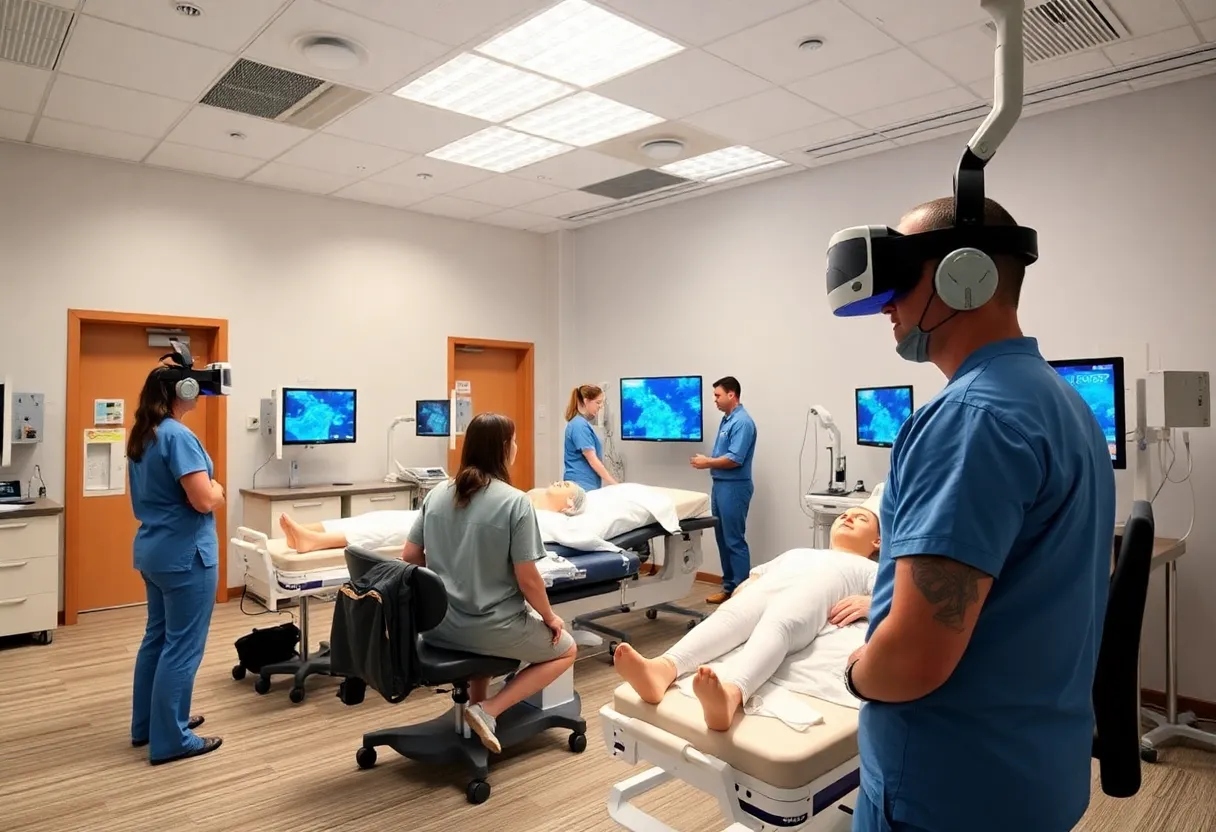Midwest City, October 21, 2025
Rose State College in Midwest City has unveiled its newly expanded Health Sciences Center, featuring advanced simulation labs to enhance training for nursing and allied health students. This $3 million upgrade includes virtual reality mannequins and interactive emergency scenarios, increasing capacity to address Oklahoma’s projected nursing shortage of 5,000 positions by 2030. The facility aims to better prepare students for real-world medical challenges through hands-on experience and modern technology.
Midwest City, OK – Rose State College Opens Expanded Health Sciences Center
Midwest City, OK – Rose State College in Midwest City has opened its expanded Health Sciences Center, introducing advanced simulation labs designed to enhance training for nursing and allied health students. The upgrade, valued at $3 million, was completed ahead of schedule and now includes virtual reality mannequins and interactive emergency scenarios. These features aim to better equip students for real-world medical situations, addressing key gaps in practical healthcare education.
The new facilities represent a significant step forward in preparing graduates for Oklahoma’s growing healthcare demands. The center’s expansion allows it to accommodate 25% more students than before, directly tackling the state’s projected nursing shortage. Officials estimate that Oklahoma could face a deficit of 5,000 nursing positions by 2030, making such investments crucial for workforce development in the region.
Facility Upgrades and Technology Integration
The renovated Health Sciences Center incorporates state-of-the-art equipment to simulate complex medical environments. Virtual reality mannequins enable students to practice procedures in a controlled setting, mimicking patient responses and critical conditions. Interactive scenarios cover emergencies like cardiac arrests and trauma cases, providing hands-on experience without real-world risks. This technology-driven approach ensures that trainees develop skills in diagnosis, treatment, and patient care under realistic pressures.
Funding for the project came from a mix of federal grants and contributions from private donors, allowing the college to complete the work efficiently. The expansion not only increases capacity but also updates outdated infrastructure, aligning the center with modern healthcare standards. As a result, Rose State College can now offer more robust programs in nursing, emergency medical services, and other allied health fields.
Impact on Students and the Healthcare Sector
Students at Rose State College will benefit from the enhanced training opportunities, which emphasize practical application over traditional classroom learning. The simulation labs allow for repeated practice of high-stakes procedures, building confidence and competence. This focus on experiential education is expected to improve pass rates on certification exams and reduce the time new graduates need to adapt in professional settings.
In Oklahoma’s healthcare landscape, where demand for skilled professionals continues to rise, the center’s upgrades play a vital role. The Oklahoma City metro area, served by Rose State College, relies on institutions like this to supply trained workers to hospitals, clinics, and long-term care facilities. By increasing enrollment capacity, the college helps meet local needs while contributing to statewide efforts to bolster the healthcare workforce.
Community and Stakeholder Response
The opening event drew alumni, healthcare partners, and local leaders, who recognized the center’s potential to strengthen community health services. Attendees highlighted the practical orientation of the new labs, noting how they bridge the gap between academic training and clinical practice. This development reinforces Rose State College’s position as a leader in vocational education within the Oklahoma City area.
Broader context shows that healthcare education initiatives like this are part of ongoing responses to demographic shifts and an aging population in Oklahoma. The state’s healthcare sector has seen steady growth, but shortages in specialized roles persist. Rose State College’s investment aligns with these trends, ensuring that future nurses and technicians are well-prepared for evolving challenges.
Future Outlook for the Program
Looking ahead, the expanded center is set to support increased enrollment and program diversification. Plans include integrating additional simulations for emerging fields like telehealth and mental health support. As Oklahoma’s nursing needs intensify, facilities like this will be essential in sustaining quality care across urban and rural communities.
The timely completion of the project underscores efficient use of resources, setting a model for similar upgrades at other community colleges. By prioritizing technology and accessibility, Rose State College continues to adapt to the demands of a dynamic job market, benefiting students, employers, and patients alike.
FAQ
What is the Rose State College Health Sciences Center expansion about?
Rose State College in Midwest City celebrated the opening of its expanded Health Sciences Center today, adding state-of-the-art simulation labs for nursing and allied health training. The $3 million facility upgrade, completed ahead of schedule, features virtual reality mannequins and interactive emergency scenarios to better prepare students for real-world medical challenges.
How was the Health Sciences Center funded?
Funded through federal grants and private donors, the center can now accommodate 25% more students, addressing a nursing shortage projected to reach 5,000 positions statewide by 2030.
What impact does the expansion have on students?
College President Dr. Natalie Nagem emphasized, ‘These enhancements will boost our graduates’ employability in Oklahoma’s healthcare sector.’ Student nurse Emily Carter shared, ‘Practicing on VR patients feels so realistic—it’s game-changing.’
How does this affect Oklahoma’s healthcare?
This development strengthens Rose State’s reputation as a key player in workforce development for the Oklahoma City metro area.
Key Features of the Expanded Health Sciences Center
| Feature | Description |
|---|---|
| Cost | $3 million |
| Completion Status | Ahead of schedule |
| New Capacity | Accommodates 25% more students |
| Technology | Virtual reality mannequins and interactive emergency scenarios |
| Focus Areas | Nursing and allied health training |
| Projected Impact | Addresses nursing shortage of 5,000 positions by 2030 |
Deeper Dive: News & Info About This Topic
HERE Resources
Oklahoma City University Unveils Center for Innovation in Entrepreneurship
University of Oklahoma Launches $75 Million Biotech Research Center
OU Health Sciences Center Marks Milestone with New Lab Space
Oklahoma City University Unveils Innovation and Entrepreneurship Center
New CEO Appointed to Lead Oklahoma’s Regional University System
Oklahoma City Council to Vote on $10 Million Incentives for Biotech Growth





